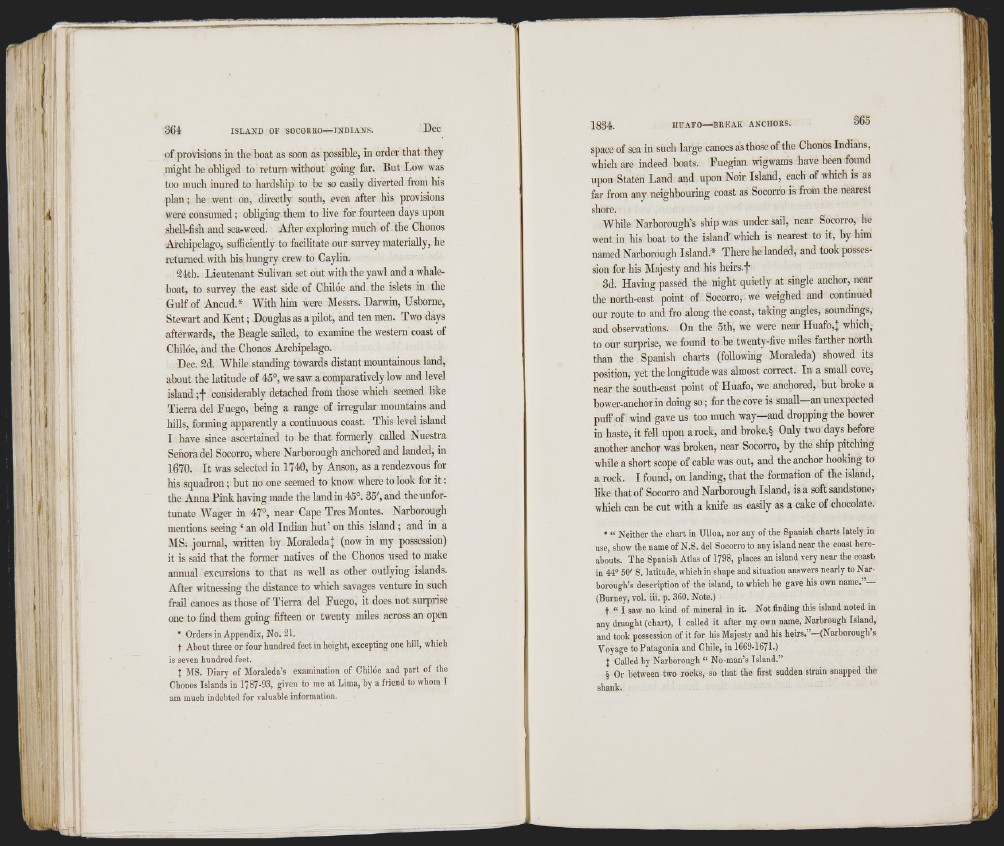
T í I
1 í» 4
l í
of provisions in the boat as soon as possible, in order that they
might be obliged to return without going far. But Low was
too much inured to hardship to be so easily diverted from his
plan ; he went on, directly south, even after his provisions
were consumed ; obliging them to live for fourteen days upon
shell-fish and sea-weed. After exploring much of the Chonos
Archipelago, sufficiently to facilitate our survey materially, he
returned with his hungry crew to Caylin.
24th. Lieutenant Sulivan set out with the yawl and a whaleboat,
to survey the east side of Chiloe and the islets in the
Gulf of Ancud.* With him were Messrs. Darwin, Usborne,
Stewart and Kent; Douglas as a pilot, and ten men. Two days
afterwards, the Beagle sailed, to examine the western coast of
Childe, and the Chonos Archipelago.
Dec. 2d. While standing towai’ds distant mountainous land,
about the latitude of 45°, we saw a comparatively low and level
island ;-f- considerably detached from those which seemed like
Tierra del Luego, being a range of irregular mountains and
hills, forming apparently a continuous coast. This level island
I have since ascertained to be that formerly called Nuestra
Señora del Socorro, where Narborough anchored and landed, in
1670. It was selected in 1740, by Anson, as a rendezvous for
his squadron; but no one seemed to know where to look for i t :
the Anna Pink having made the land in 45°. 35', and the unfortunate
Wager in 47°, near Cape Tres Montes. Narborough
mentions seeing ‘ an old Indian hut’ on this island ; and in a
MS. journal, written by Moraleda] (now in my possession)
it is said that the former natives of the Chonos used to make
annual excursions to that as well as other outlying islands.
After witnessing the distance to which savages venture in such
frail canoes as those of Tierra del Fuego, it does not surprise
one to find them going fifteen or twenty miles across an open
* Orders in Appendix, No. 21.
t About tbree or four hundred feet in height, excepting one hill, which
is seven hundred feet.
Í MS. Diary of Moraleda’s examination of Chilóe and part of the
Chonos Islands in 1787-93, given to me at Lima, hy a friend to whom I
am much indebted for valuable information.
space of sea in such large canoes as those of the Chonos Indians,
which ai-e indeed boats. Fuegian wigwams have been found
upon Staten Land and upon Noir Island, each of which is as
far from any neighbouring coast as Socorro is from the nearest
shore.
While Narborough’s ship was under sail, near Socorro, he
went in his boat to the island'which is nearest to it, hy him
named Narborough Island.* There he landed, and took possession
for his Majesty and his heirs.f
3d. Having passed the night quietly at single anchor, near
the north-east point of Socorro, we weighed and continued
our route to and fro along the coast, taking angles, soundings,
and observations. On the 5th, we were near Huafo,] which,
to our surprise, we found to be twenty-five miles farther north
than the Spanish charts (following Moraleda) showed its
position, yet the longitude was almost correct. In a smdl cove,
near the south-east point of Huafo, we anchored, but broke a
bower-anchor in doing so; for the cove is small—an unexpected
puff of wind gave us too much way—and dropping the bower
in haste, it fell upon a rock, and broke.% Only two days before
another anchor was broken, near Socorro, by the ship pitching
while a short scope of cable was out, and the anchor hooking to
a rock. I found, on landing, that the formation of the island,
like that of Socorro and Narborough Island, is a soft sandstone,
which can be cut with a knife as easily as a cake of chocolate.
• “ Neither the chart in Ulloa, nor any of the Spanish charts lately in
use, show the name of N.S. del Socorro to any island near the coast hereabouts.
The Spanish Atlas of 1798, places an island very near the coast,
in 44° 50' S. latitude, which in shape and situation answers nearly to Narborough’s
description of the island, to which he gave his own name.”
(Burney, vol. iii. p. 360. Note.)
t “ I saw no kind of mineral in it. Not finding this island noted in
any draught (chart), I called it after my own name, Narbrough Island,
and took possession of it for his Majesty and his heirs.”—(Narborough’s
Voyage to Patagonia and Chile, in 1669-1671.)
J Called by Narborough “ No-man’s Island.”
§ Or between two rocks, so that the first sudden strain snapped the
shank.